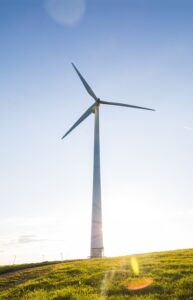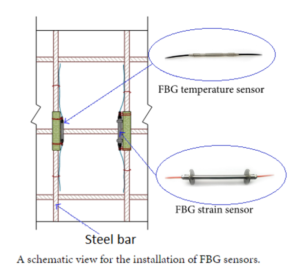 Aircraft structures require regular, scheduled inspections and monitoring of all possible hazards due to their special conditions and the principles of their design. Therefore, structural health monitoring is conducted through fiber optic devices and has great potential to reduce the costs related to these operations. Fiber optic devices applied to the monitoring of aircraft structures provide some advantages over traditional devices. Fiber Bragg grating sensors have proved to constitute the most promising technology in this field. In order to prolong the operation period of all kinds of complex engineering systems and avoid catastrophic failures, so it is necessary to achieve the highest levels of damage detection. The automation of the inspection process is a point of major importance to reduce inspection efforts. The structural health monitoring system on the basis of fiber optic products can be defined as a set of devices that provide information that allows us to locate, evaluate, and predict the loading and damage conditions of a structure. The structural health monitoring of aircraft structures can conduct real-time checks, reducing costs, and improving the reliability and performance of the structures. A wide range of potential structural health monitoring technologies is being developed to meet these needs, and the most promising options are:
Aircraft structures require regular, scheduled inspections and monitoring of all possible hazards due to their special conditions and the principles of their design. Therefore, structural health monitoring is conducted through fiber optic devices and has great potential to reduce the costs related to these operations. Fiber optic devices applied to the monitoring of aircraft structures provide some advantages over traditional devices. Fiber Bragg grating sensors have proved to constitute the most promising technology in this field. In order to prolong the operation period of all kinds of complex engineering systems and avoid catastrophic failures, so it is necessary to achieve the highest levels of damage detection. The automation of the inspection process is a point of major importance to reduce inspection efforts. The structural health monitoring system on the basis of fiber optic products can be defined as a set of devices that provide information that allows us to locate, evaluate, and predict the loading and damage conditions of a structure. The structural health monitoring of aircraft structures can conduct real-time checks, reducing costs, and improving the reliability and performance of the structures. A wide range of potential structural health monitoring technologies is being developed to meet these needs, and the most promising options are:
- electrical strain gauges and crack wires
- acoustic emissions methods
- optical-based technologies
- comparative vacuum monitoring
- microelectromechanical systems (MEMS)
Fiber optic products and fiber optic devices, in general, are very appropriate to perform structural health monitoring due to the fact that they have their intrinsic capabilities, such as sensitivity to electromagnetic radiation, low weight, compact size, great sensitivity and resolution, and their suitability to be embedded into structures. Fiber optic devices for monitoring the strain in aircraft structures can be classified into the following categories: intensity-based, interferometric, distributed, and grating-based fiber optic devices.
Among grating-based sensors, FBGs and probably the most mature and widely employed optical sensors for structural health monitoring of engineering structures due to their fast development achieved in recent years. Fiber Bragg grating sensors have important advantages over conventional strain sensors:
- high sensitivity and resolution, low weight and small size, the absence of the electromagnetic interference
- suitability for being attached to a structure or embedded in composite materials
- high multiplexing capability
- wavelength-encoded sensing in a way that is totally independent of the optical intensity
- different magnitudes can be measured using FBGs, such as strain, temperature, vibration, or humidity.
Optromix is a fast-growing vendor of fiber Bragg grating (FBG) products line: fiber Bragg grating sensors, FBG interrogators, and multiplexers, Distributed Temperature Sensing (DTS) systems. We create and supply a broad variety of top-notch fiber optic solutions for the monitoring of various facilities all over the world.
If you are interested in Optromix FBG sensors, please contact us at info@optromix.com


 A traditional way of monitoring structural health is through the use of piezoelectric transducers; these devices convert pressure to an electric voltage. Transducers are reliable and accurate in most working conditions except in cases of corrosive environments or under high temperatures, above 300° Celsius. Harsh conditions influence reliability. accuracy, and usefulness of transducers in a negative way.
A traditional way of monitoring structural health is through the use of piezoelectric transducers; these devices convert pressure to an electric voltage. Transducers are reliable and accurate in most working conditions except in cases of corrosive environments or under high temperatures, above 300° Celsius. Harsh conditions influence reliability. accuracy, and usefulness of transducers in a negative way. The increased demand for energy due to the growing population has forced the industry to develop new sustainable ways to produce energy. Among new and developing energy technologies are wind turbines. They are widely used to produce energy in many parts of the world. However, there are multiple concerns that are yet to be solved, one of them has been the lack of effective monitoring devices and techniques.
The increased demand for energy due to the growing population has forced the industry to develop new sustainable ways to produce energy. Among new and developing energy technologies are wind turbines. They are widely used to produce energy in many parts of the world. However, there are multiple concerns that are yet to be solved, one of them has been the lack of effective monitoring devices and techniques.  Nowadays, numerous civil infrastructures have been built in metropolitan areas all over the world. The performance of these infrastructures during construction, operation, maintenance, and upgrading is a major concern for society. The use of smart
Nowadays, numerous civil infrastructures have been built in metropolitan areas all over the world. The performance of these infrastructures during construction, operation, maintenance, and upgrading is a major concern for society. The use of smart